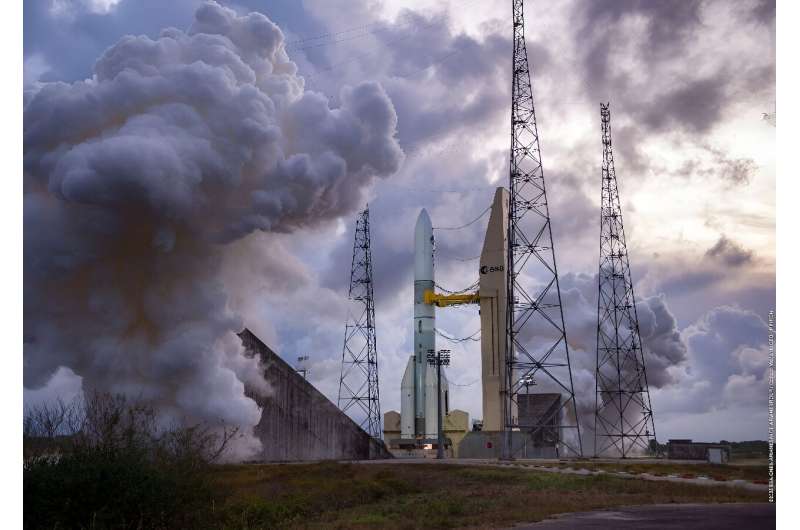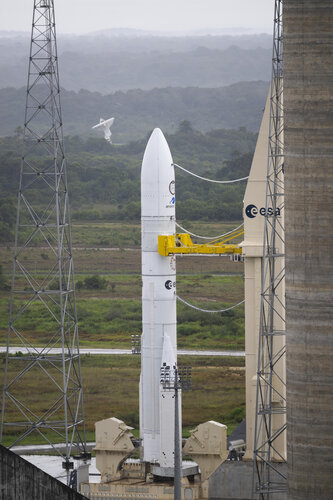Blue Origin and Stoke Space Join US Space Force OSP-4 Launch Contract
Tuesday, 09 July 2024 15:49 The U.S. Space Force's Small Launch and Targets Division at Kirtland Air Force Base in Albuquerque, New Mexico, a segment of Space Systems Command's (SSC) Assured Access to Space (AATS) program, announced the addition of Blue Origin and Stoke Space Technologies Inc. to the Orbital Services Program (OSP)-4 Indefinite Delivery/Indefinite Quantity (IDIQ) contract.
OSP-4, part of the Rocket Sy
The U.S. Space Force's Small Launch and Targets Division at Kirtland Air Force Base in Albuquerque, New Mexico, a segment of Space Systems Command's (SSC) Assured Access to Space (AATS) program, announced the addition of Blue Origin and Stoke Space Technologies Inc. to the Orbital Services Program (OSP)-4 Indefinite Delivery/Indefinite Quantity (IDIQ) contract.
OSP-4, part of the Rocket Sy NASA moon rocket stage for Artemis II moved, prepped for shipment
Tuesday, 09 July 2024 15:23
NASA is preparing the SLS (Space Launch System) rocket core stage that will help power the first crewed mission of NASA's Artemis campaign for shipment. On July 6, NASA and Boeing, the core stage lead contractor, moved the Artemis II rocket stage to another part of the agency's Michoud Assembly Facility in New Orleans. The move comes as teams prepare to roll the massive rocket stage to the agency's Pegasus barge for delivery to NASA's Kennedy Space Center in Florida in mid-July.
Prior to the move, technicians began removing external access stands, or scaffolding, surrounding the rocket stage in early June. NASA and Boeing teams used the scaffolding surrounding the core stage to assess the interior elements, including its complex avionics and propulsion systems. The 212-foot core stage has two huge propellant tanks, avionics and flight computer systems, and four RS-25 engines, which together enable the stage to operate during launch and flight.
The stage is fully manufactured and assembled at Michoud. Building, assembling, and transporting is a joint process for NASA, Boeing, and lead RS-25 engines contractor Aerojet Rocketdyne, an L3Harris Technologies company.
Ariane 6 takes flight
Tuesday, 09 July 2024 14:33 Image:
Image:
Ariane 6 launches to the sky on 9 July 2024.
Europe’s newest heavy-lift rocket, it is designed to provide great power and flexibility at a lower cost than its predecessors. The launcher’s configuration – with an upgraded main stage, a choice of either two or four powerful boosters and a new restartable upper stage – will provide Europe with greater efficiency and possibility as it can launch multiple missions into different orbits on a single flight, while its upper stage will deorbit itself at the end of mission.
Ariane 6 VA262
Tuesday, 09 July 2024 14:33 Image:
Image:
Launch of Ariane 6 VA262 on 9 July 2024 from Europe’s Spaceport in French Guiana.
This is Europe’s newest heavy-lift rocket, designed to provide greater power and flexibility at a lower cost than its predecessors. The launcher’s configuration – with an upgraded main stage, a choice of either two or four powerful boosters and a new restartable upper stage – will provide Europe with greater efficiency and possibility as it can launch multiple missions into different orbits on a single flight, while its upper stage will be able to deorbit itself at the end of missions.
Ariane 6 from above in the final hours before liftoff
Tuesday, 09 July 2024 13:41 Image:
Ariane 6 from above in the final hours before liftoff
Image:
Ariane 6 from above in the final hours before liftoff Germany's Integral Role in the Ariane 6 Launch Program
Tuesday, 09 July 2024 13:13 The Ariane 6, Europe's new launcher, is set for its maiden voyage on 9 July 2024. This rocket aims to provide Europe with reliable and cost-effective access to space, succeeding the Ariane 5 while offering greater flexibility. Germany stands as the second-largest contributor to the European Space Agency's (ESA) Ariane 6 program, with the German Space Agency at the German Aerospace Center (DLR) i
The Ariane 6, Europe's new launcher, is set for its maiden voyage on 9 July 2024. This rocket aims to provide Europe with reliable and cost-effective access to space, succeeding the Ariane 5 while offering greater flexibility. Germany stands as the second-largest contributor to the European Space Agency's (ESA) Ariane 6 program, with the German Space Agency at the German Aerospace Center (DLR) i Artemis IV Set to Launch with Modernized RS-25 Engines
Tuesday, 09 July 2024 13:13 Aerojet Rocketdyne, an L3Harris Technologies (NYSE:LHX) company, has successfully upgraded the four RS-25 engines that will propel NASA's Space Launch System (SLS) rocket for the Artemis IV mission. This mission will feature the first flight of the advanced Block 1B configuration of the SLS rocket and will be the last to use engines from the space shuttle era.
The upgraded Artemis IV engin
Aerojet Rocketdyne, an L3Harris Technologies (NYSE:LHX) company, has successfully upgraded the four RS-25 engines that will propel NASA's Space Launch System (SLS) rocket for the Artemis IV mission. This mission will feature the first flight of the advanced Block 1B configuration of the SLS rocket and will be the last to use engines from the space shuttle era.
The upgraded Artemis IV engin Orion and SLS Gearing Up for Major Artemis Missions
Tuesday, 09 July 2024 13:13 NASA's Artemis program, aimed at returning humans to the Moon and beyond, is making significant strides with key developments in the Orion spacecraft and the Space Launch System (SLS) rocket. These advancements are vital as the space agency prepares for a series of increasingly ambitious missions to explore cislunar space and establish a sustainable human presence on the Moon.
b>Orion Spa
NASA's Artemis program, aimed at returning humans to the Moon and beyond, is making significant strides with key developments in the Orion spacecraft and the Space Launch System (SLS) rocket. These advancements are vital as the space agency prepares for a series of increasingly ambitious missions to explore cislunar space and establish a sustainable human presence on the Moon.
b>Orion Spa Martian Atmosphere Unveiled Through Innovative Use of Existing Technology
Tuesday, 09 July 2024 13:13 An antenna on ExoMars' Trace Gas Orbiter has been repurposed to help researchers explore new areas of the Martian atmosphere.
Using this modified equipment, a team including researchers from Imperial College London has investigated previously unreachable regions of Mars' atmosphere. These areas, which can obstruct radio signals, are vital for future Mars habitation missions.
The anal
An antenna on ExoMars' Trace Gas Orbiter has been repurposed to help researchers explore new areas of the Martian atmosphere.
Using this modified equipment, a team including researchers from Imperial College London has investigated previously unreachable regions of Mars' atmosphere. These areas, which can obstruct radio signals, are vital for future Mars habitation missions.
The anal Subaru Telescope Discovers New Objects Beyond the Kuiper Belt
Tuesday, 09 July 2024 13:13 The Subaru Telescope's comprehensive imaging has significantly contributed to the New Horizons mission, revealing potential extensions of the Kuiper Belt in the outer Solar System. By utilizing a unique analytical method on images captured by the telescope's ultra-wide-field camera, researchers have identified objects that might extend the known boundaries of the Kuiper Belt.
Beyond Neptun
The Subaru Telescope's comprehensive imaging has significantly contributed to the New Horizons mission, revealing potential extensions of the Kuiper Belt in the outer Solar System. By utilizing a unique analytical method on images captured by the telescope's ultra-wide-field camera, researchers have identified objects that might extend the known boundaries of the Kuiper Belt.
Beyond Neptun SpaceX Successfully Launches Turkey's First Home-Grown Communications Satellite
Tuesday, 09 July 2024 13:13 SpaceX has launched a Falcon 9 rocket from Cape Canaveral Space Force Station on Monday night, carrying Turkey's first home-grown communications satellite.
The launch took place at 7:30 p.m. EDT after being delayed due to bad weather. The event was streamed online for viewers worldwide.
"All systems are looking good for today's launch of the @Turksat 6A mission from Florida. Weather
SpaceX has launched a Falcon 9 rocket from Cape Canaveral Space Force Station on Monday night, carrying Turkey's first home-grown communications satellite.
The launch took place at 7:30 p.m. EDT after being delayed due to bad weather. The event was streamed online for viewers worldwide.
"All systems are looking good for today's launch of the @Turksat 6A mission from Florida. Weather Nearby Exoplanet Found with Hydrogen Sulfide Atmosphere
Tuesday, 09 July 2024 13:13 A recent study by Johns Hopkins University, utilizing data from the James Webb Space Telescope, has uncovered that the atmosphere of the exoplanet HD 189733 b contains trace amounts of hydrogen sulfide, known for its rotten egg odor.
HD 189733 b, a gas giant similar in size to Jupiter, reveals new information about sulfur's role in planetary formation and atmospheric composition. The prese
A recent study by Johns Hopkins University, utilizing data from the James Webb Space Telescope, has uncovered that the atmosphere of the exoplanet HD 189733 b contains trace amounts of hydrogen sulfide, known for its rotten egg odor.
HD 189733 b, a gas giant similar in size to Jupiter, reveals new information about sulfur's role in planetary formation and atmospheric composition. The prese Countdown to first launch of Europe's Ariane 6 rocket
Tuesday, 09 July 2024 13:10
After four years of delays, Europe's new Ariane 6 rocket is set to blast off for the first time on Tuesday, carrying with it the continent's hopes of regaining independent access to space.
The inaugural flight of the European Space Agency's (ESA) most powerful rocket yet is scheduled to launch from Europe's spaceport in Kourou, French Guiana at 3pm local time (1800 GMT).
Since the last flight of the rocket's workhorse predecessor, Ariane 5, a year ago, Europe has been unable to launch satellites or other missions into space without relying on rivals such as Elon Musk's US firm SpaceX.
So many will be nervously watching the launch, hoping it can bring an end to a difficult era for European space efforts.
Ariane 6 sees 'first light' as mobile gantry is rolled back before fuelling begins
Tuesday, 09 July 2024 12:15 Image:
Ariane 6 sees 'first light' as mobile gantry is rolled back before fuelling begins
Image:
Ariane 6 sees 'first light' as mobile gantry is rolled back before fuelling begins 


